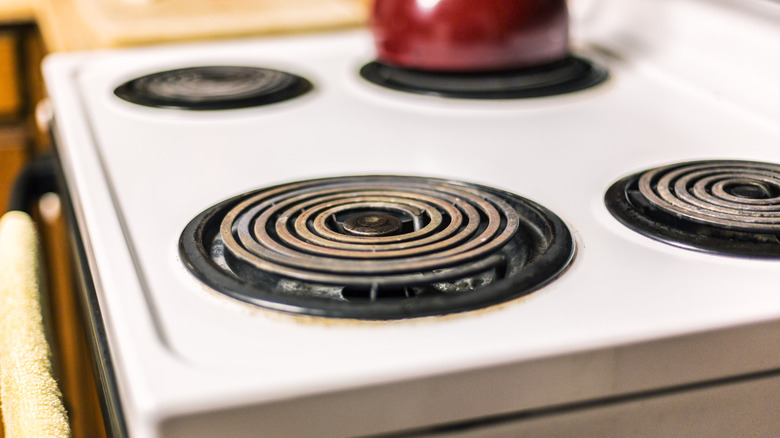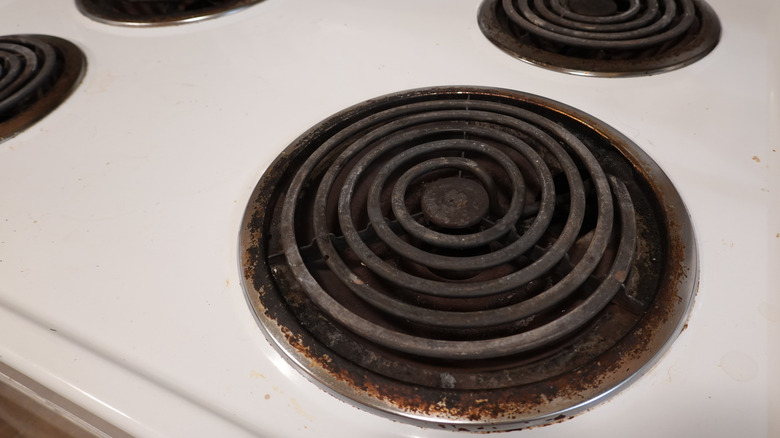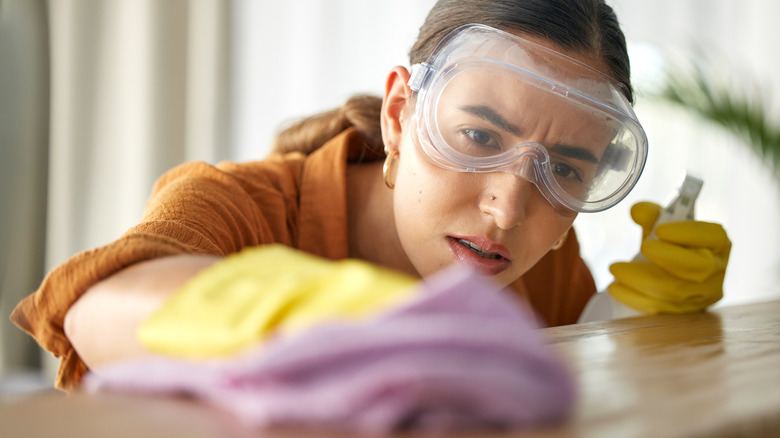The Secret Ingredient That'll Leave Your Electric Stovetop Burners Sparkling
Many kitchens these days have appliances that have somehow hung on from years past, one of them being an older-style electric stove with coiled burners. Cleaning these electric stovetop burners, in comparison to the much easier flat cooktops, can be challenging due to the accumulation of stubborn grease, food residue, and burnt-on stains over time. Unlike smooth surfaces, the uneven and often porous texture of burner coils or grates can trap dirt, making it harder to remove with regular cleaning methods.
Additionally, the high temperatures reached during cooking can cause spills and splatters to become baked onto the burners, requiring more effort to scrub away. Accessing and removing the burners for thorough cleaning can be cumbersome, especially if they are secured with screws or clips. Nevertheless, the chore must be done, and one cleaning product that can help you swiftly restore the gleam to your burners is a bottle of ammonia.
Ammonia is effective for cleaning electric stovetop burners due to its powerful degreasing and solvent properties. Its alkaline nature helps break down and dissolve tough grease, grime, and burnt-on residues, making them easier to remove. Additionally, ammonia's ability to cut through stubborn stains and lift away dirt makes it particularly useful for cleaning filthy surfaces such as burner coils or grates. Moreover, ammonia's versatility allows it to be diluted with water to create an effective cleaning solution. Overall, the combination of ammonia's degreasing power, solvent properties, and ability to tackle tough stains makes it a handy cleaning tool.
How to use ammonia to clean your stovetop burners
Cleaning electric stovetop burners with ammonia can be an effective method for removing tough stains and grease buildup. Before you begin, ensure the stovetop is turned off and completely cool before starting the cleaning process to avoid any accidents or burns. To start, carefully remove the electric burners from the stovetop. Depending on your stove model, they may lift out easily or require unscrewing. Once removed, place them in a large resealable plastic bag. You may need to use a separate bag for each burner; gallon-size should fit one burner each. Next, pour ¼ cup of ammonia into each bag and seal them shut with the electrical prongs at the top of the bag away from the liquid. Consider doing this step in a well-ventilated area to avoid inhaling the fumes.
Allow the burners to sit in the ammonia bags for at least a few hours or overnight for best results. The ammonia does not need to completely cover the burners as the fumes will actually be doing most of the cleaning within the bag. After soaking, carefully remove the burners from the plastic bags. Use a scrubbing sponge or brush to gently scrub away any remaining grime or residue. Rinse the burners thoroughly with water to remove any traces of ammonia. Once cleaned, allow the burners to air dry completely before reinstalling them onto the stovetop. Remember to dispose of the ammonia solution properly and wash your hands thoroughly after handling.
Cautions for using ammonia
While ammonia can be effective for cleaning electric stovetop burners, it's essential to be aware of the precautions and potential dangers associated with its use. Ammonia emits strong fumes that are irritating to the eyes, nose, and throat. These fumes can cause discomfort or respiratory issues, particularly in poorly ventilated areas.
Therefore, it's essential to work in a well-ventilated space or near open windows to use ammonia effectively in the home. It's also a good idea to wear protective gear such as gloves and goggles to prevent skin and eye irritation. Avoid direct contact with undiluted ammonia and ensure proper handling to minimize the risk of spills or accidents. Keep ammonia out of reach of children and pets, as ingestion or prolonged exposure can be harmful. Store ammonia in a secure location, preferably in its original container, and follow proper disposal procedures for unused or expired products.
Another important caution is to never mix ammonia with other cleaning agents, especially bleach. Combining ammonia with bleach produces a toxic gas called chloramine, which can cause severe respiratory problems and even be fatal. Always read labels carefully and avoid mixing cleaning products containing ammonia with any other substances. Additionally, ammonia can be harsh on certain surfaces, particularly those made of soft metals like aluminum. It's essential to check the manufacturer's recommendations for cleaning your electric stovetop burners to ensure they are compatible with ammonia. Using ammonia on incompatible surfaces can lead to discoloration, corrosion, or other damage.


